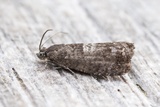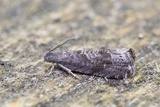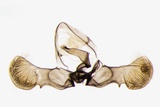Aspila funebrana Treitschke, 1835 Species
Last modified: Nov. 24, 2025, 7:34 p.m.
A fairly common species throughout Belgium.
Details
- Classification
- Family: Tortricidae > Subfamily: Olethreutinae > Tribus: Grapholitini > Genus: Aspila > Species: Aspila funebrana
- Vernacular names
- Pruimenmot (NL), Plum Fruit Moth (EN), Pflaumenwickler (DE)
- First mention in Belgium
- De Crombrugghe G. 1906a. Catalogue raisonné des Microlépidoptères de Belgique. — Mémoires de la Société entomologique de Belgique XIII: 1–172; XIV: 1–155. On page 137.
- Status
-
Native
Distribution
Imago
Wingspan 10–15 mm. The forewings becoming dark grey-brown mainly overlaid with fuscous brown with indistinct silvery-grey markings on the dorsum and around the poorly-defined ocellus which contain a few black spots. Hind wings are brownish-grey. Dull greyish brown palps or concolorous with forewing.
Egg
Eggs are flattened and slightly elliptical, about 0.6 mm wide by 0.7 mm across. They are translucent white, becoming yellow as they mature.
Caterpillar
Early instar larvae are whitish with a black head and prothoracic shield. Last instars are about 10-12 mm and are carmine red with a dark brown head and brownish nape and anal shield with dark mottling.
Bionomics
First generation females lay eggs singly on fruitlets. Second generation females lay eggs near the base of maturing fruit. The larva enters the fruit and tunnels into the pericarp, mainly in the neighbourhood of the kernel. Sap and gum may ooze from the entrance hole. Later the full grown larva leaves the fruit and pupates in a cocoon spun on tree bark or amongst plant debris on the ground.
The males are attracted to the pheromone developed for this species and both adults come to light.
Flight periods
The adults have been seen from early April towards early October in different generations a year.
Observed on
- Host plant (species):
- Prunus domestica
- Host plant (genera):
- Prunus
The larva feeds mainly on Prunus domestica. Notifications of Prunus spinosa and other Prunus species are rather rare exceptions. It can be a serious pest especially in orchards.
Habitat
It inhabits gardens, orchards and places where plums grown.




